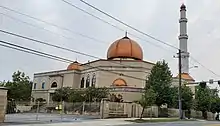Al-Farooq Masjid
Al-Farooq Masjid is a mosque in Atlanta, Georgia, United States. Founded in 1980, the mosque is one of the largest in the Southeastern United States. The current building, located in Atlanta's Home Park neighborhood, was completed in 2008.
| Al-Farooq Masjid | |
|---|---|
 Al-Farooq Masjid (2020) | |
| Religion | |
| Affiliation | Islam |
| Location | |
| Location | 442 14th Street Atlanta |
| State | Georgia |
| Country | United States |
 Shown within Atlanta  Al-Farooq Masjid (Georgia (U.S. state))  Al-Farooq Masjid (the United States) | |
| Geographic coordinates | 33°47′8″N 84°24′4″W |
| Architecture | |
| Date established | 1980 |
| Completed | 2008 |
| Construction cost | $10 million |
| Capacity | 5,000 |
| Website | |
| alfarooqmasjid.org | |
History
Al-Farooq Masjid was founded in Atlanta in 1980 in response to a growing population of South Asian Muslims in the city, including students from the Georgia Institute of Technology (Georgia Tech).[1] The mosque was the first majority-immigrant mosque in the city,[2] though several mosques serving African-American Muslims were present in the city at the time.[3][4] It was established in Home Park, a neighborhood close to Georgia Tech's campus.[2] The mosque later established a cemetery, and in the 1990s they opened two schools.[5] In 1990, the mosque opened a K-8 school,[6][1] and in 1992 another school was opened, focusing on Islamic studies.[1] Al-Farooq later established an affiliated mosque in Norcross, Georgia.[1]
In 1999, the mosque began a series of major renovations,[1] and in 2003, construction began on a new mosque building.[5] This building, which cost $10 million, was completed in 2008.[7] The new building features two copper domes, the larger of which reminiscent of the Dome of the Rock in Jerusalem,[7] and can hold an estimated 5,000 people.[1] The new octagonal-shpaed building also features a tall minaret, mashrabiya-covered balconies, and entryways featuring pointed arches.[7] As of 2015, the mosque averaged approximately 1,000 attendees to Friday prayer sessions.[7]
References
- Barzegar 2010, p. 69.
- Karim 2009, p. 167.
- Barzegar 2010, pp. 68–70.
- Thangaraj 2015, p. 47.
- Ramey 2006, p. 80.
- Karim 2009, p. 169.
- Curiel 2015, p. 63.
Bibliography
- Barzegar, Abbas (2010). Curtis IV, Edward E. (ed.). Encyclopedia of Muslim-American History. Infobase Publishing. pp. 68–72. ISBN 978-1-4381-3040-8 – via Google Books.CS1 maint: ref=harv (link)
- Curiel, Jonathan (2015). Islam in America. I.B. Tauris. ISBN 978-0-85772-483-0 – via Google Books.CS1 maint: ref=harv (link)
- Karim, Jamillah (2009). American Muslim Women: Negotiating Race, Class, and Gender Within the Ummah. New York University Press. ISBN 978-0-8147-4809-1 – via Google Books.CS1 maint: ref=harv (link)
- Ramey, Steven (2006). Hill, Samuel S. (ed.). The New Encyclopedia of Southern Culture: Volume 1: Religion. University of North Carolina Press. pp. 79–81. ISBN 978-0-8078-7716-6 – via Google Books.CS1 maint: ref=harv (link)
- Thangaraj, Stanley (2015). King, C. Richard (ed.). Asian American Athletes in Sport and Society. Routledge. pp. 47–66. ISBN 978-1-317-59532-8 – via Google Books.CS1 maint: ref=harv (link)
External links
 Media related to Al-Farooq Masjid at Wikimedia Commons
Media related to Al-Farooq Masjid at Wikimedia Commons- Official website